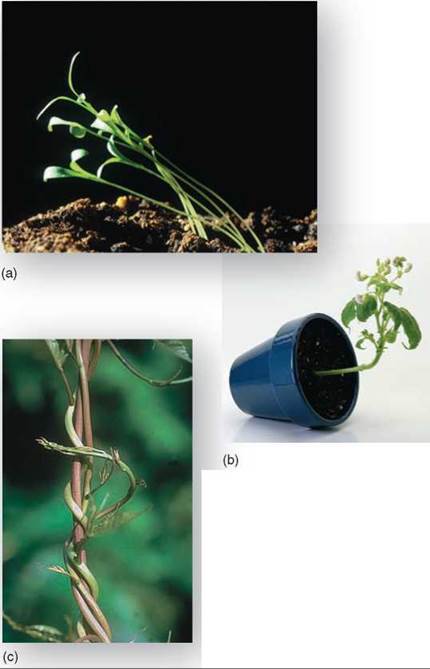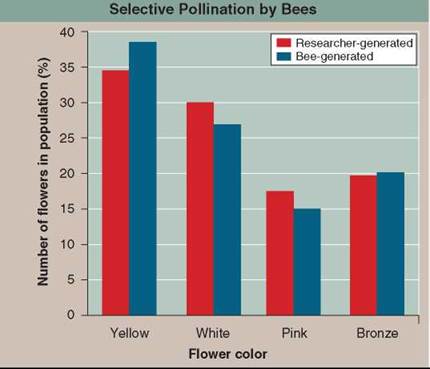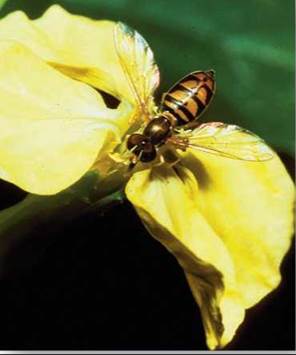THE LIVING WORLD
Unit Seven. Plant Life
34. Plant Reproduction and Growth
34.11. Tropisms
Tropisms are directional and irreversible growth responses of plants to external stimuli. They control patterns of plant growth and thus plant appearance. Three major classes of plant tropisms include phototropism (figure 34.15a, as discussed earlier), gravitropism, and thigmotropism.
Gravitropism
Gravitropism causes stems to grow upward and roots downward in response to gravity. Both of these responses clearly have adaptive significance. Stems, like the one growing from a tipped over flower pot in figure 34.15b, grow upward and are apt to receive more light than those that do not; roots that grow downward are more apt to encounter a more favorable environment than those that do not.
Thigmotropism
Still another commonly observed response of plants is thigmotropism, a name derived from the Greek root thigma, meaning “touch.” Thigmotropism is defined as the response of plants to touch. Examples include plant tendrils, which rapidly curl around and cling to stems or other objects, and twining plants, such as bindweed, which also coil around objects (figure 34.15c). These behaviors result from rapid growth responses to touch. Specialized groups of cells in the plant epidermis appear to be concerned with thigmotropic reactions, but again, their exact mode of action is not well understood.

Figure 34.15. Tropism guides plant growth.
(a) Phototropism is exhibited by this Coriandrum plant growing toward light. (b) Gravitropism is exhibited by this plant, Phaseolus vulgaris. Note the negative gravitational response of the shoot. (c) The thigmotropic response of these twining stems causes them to coil around the object with which they have come in contact.
Key Learning Outcome 34.11. Growth of the plant body is often sensitive to light, gravity, or touch.
Inquiry & Analysis
Are Pollinators Responsible for the Evolution of Flower Color?
Evolution results from many types of interactions among organisms, including predator-prey relationships, competition, and mate selection. An important type of coevolution among plants and animals involves flowering plants and their pollinators. Pollinators need flowers for food, and plants need pollinators for reproduction. It is logical then, to hypothesize that evolutionary changes in flower shape, size, odor, and color are driven, to a large extent, by pollinators such as bees. We know that insects respond to variation in flower traits by visiting flowers with certain features, but few studies have been carried out to predict and then evaluate the response of plant populations to selection by pollinators. In wild radish populations, honeybees preferentially visit yellow and white flowers, while syrphid flies prefer pink flowers. Rebecca Irwin and Sharon Strauss at the University of California, Davis studied the response of wild radish flower color to selection by pollinators in natural populations. They compared the frequency of four flower colors (yellow, pink, white, and bronze) in two populations of wild radishes. Bees created the first population by visiting flowers based on their color preferences. The scientists produced the second population by hand pollinating wild radish flowers with no discrimination due to flower color. However, the pollen used for artificial pollinations contained varying proportions of each type of plant, based on the frequencies of each in the wild. In the graph shown here, you can see the distribution of flower colors in these two populations. The blue bars indicate the number of plants with yellow, white, pink, and bronze flowers in the population generated by the bee pollination. The red bars show the number of each type of flower in the population generated by researcher pollination, with no selection for flower color.

1. Applying Concepts
a. Variable. In the graph, what is the dependent variable?
b. Reading a bar graph. Does this graph reflect data on flower colors from syrphid fly pollinations?
2. Interpreting Data
a. Which flower color was most common?
b. Which flower color(s) did the bees preferentially appear to visit?
3. Making Inferences
a. Which type of insect do you suppose was most abundant in the region where this study was carried out, and why?
b. Because there were pink flowers in these populations, can you say that syrphid flies had to be present in the area?
4. Drawing Conclusions
a. Does it appear that insects are influencing the evolution of flower color in wild radish populations?
b. Why did the researcher-pollinated population of flowers exhibit a similar pattern of flower colors as the bee-pollinated population? Were the researchers showing some experimental bias in their color selections?
5. Further Analysis. Assume the wild radish population in this study is visited again in 10 years and although a slight increase in yellow-flowered plants is observed, the proportion is not as high as would be predicted by this study. Provide some explanation for a slower than expected increase in the yellow-flowered plants.

An uncommon visitor: here a syrphid fly is visiting a yellow wild radish flower, usually preferred by bees.
1. Sexual reproduction in angiosperms requires
a. pollen.
b. runners.
c. rhizomes.
d. suckers.
2. The male parts of a flower include all of the following except
a. anthers.
b. stigma.
c. stamen.
d. microspores.
3. Angiosperm plants that contain both male and female flowers are called
a. dioecious.
b. monoecious.
c. imperfect.
d. incomplete.
4. The functions of flower shape, scent, color, and presence of nectar in the flowers of some angiosperms are to
a. deter predators.
b. attract animal pollinators.
c. deter insect pests.
d. enhance symbiosis.
5. For a seed to germinate, the dormant plant embryo must get
a. carbon dioxide and water.
b. nitrogen and water.
c. oxygen and nitrogen.
d. oxygen and water.
6. Fruit forms from a flower’s
a. ovary.
b. sepals.
c. carpels.
d. stigma.
7. Meristematic tissue regulates plant growth and development through the use of
a. carbohydrates.
b. amount of available water.
c. hormones.
d. phototropism.
8. The hormone auxin causes
a. cells in plant stems to shorten by releasing water.
b. fruit to ripen.
c. cells in plant stems to elongate.
d. growth of more lateral branches.
9. Angiosperm flowering is controlled by
a. temperature.
b. gibberellins.
c. photoperiod.
d. magnesium.
10. Sensitivity of plants to touch is known as
a. thigmotropism.
b. photoperiodism.
c. phototropism.
d. gravitropism.